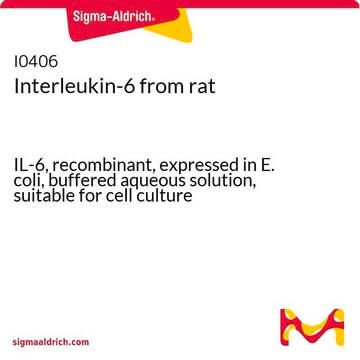SRP3096
Interleukin-6 human
Animal-component free, recombinant, expressed in E. coli, suitable for cell culture
Sinónimos:
Interleukin-6 human, IL-6
About This Item
Productos recomendados
biological source
human
Quality Level
recombinant
expressed in E. coli
assay
≥95% (SDS-PAGE)
form
lyophilized
potency
≤2.0 ng/mL ED50
mol wt
20.9 kDa
packaging
pkg of 100 μg
pkg of 20 μg
technique(s)
cell culture | mammalian: suitable
impurities
≤1 EU/μg endotoxin, tested
UniProt accession no.
shipped in
wet ice
storage temp.
-10 to -25°C
Gene Information
human ... IL6(3569)
¿Está buscando productos similares? Visita Guía de comparación de productos
General description
Application
Biochem/physiol Actions
Packaging
Sequence
Physical form
Reconstitution
signalword
Warning
hcodes
Hazard Classifications
Eye Irrit. 2 - STOT SE 3
target_organs
Respiratory system
Storage Class
11 - Combustible Solids
wgk_germany
WGK 1
flash_point_f
Not applicable
flash_point_c
Not applicable
Certificados de análisis (COA)
Busque Certificados de análisis (COA) introduciendo el número de lote del producto. Los números de lote se encuentran en la etiqueta del producto después de las palabras «Lot» o «Batch»
¿Ya tiene este producto?
Encuentre la documentación para los productos que ha comprado recientemente en la Biblioteca de documentos.
Los clientes también vieron
Protocolos
Perform colorimetric assays for nonradioactive quantification of cellular proliferation, viability, and cytotoxicity for adherent or suspension cells cultured in 96-well microplates.
MTT assay protocol for measuring cell viability, proliferation and cytotoxicity. Instructions for MTT reagent preparation and examples of applications.
Protocolo del ensayo con MTT para medir la viabilidad, la proliferación y la citotoxicidad celulares. Instrucciones para la preparación de los reactivos MTT y ejemplos de aplicaciones.
Nuestro equipo de científicos tiene experiencia en todas las áreas de investigación: Ciencias de la vida, Ciencia de los materiales, Síntesis química, Cromatografía, Analítica y muchas otras.
Póngase en contacto con el Servicio técnico









